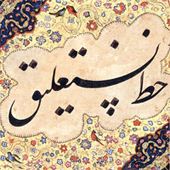
1006 A Kufic inscription at the bottom of the tower of Gonbad-i Qabus in North of Iran. This spectacular tomb tower is located near Gurgan, southeast of the Caspian Sea. The exterior takes the form of a tapering ten-pointed star; the interior is smooth and circular. In contrast to the Samanid mausoleum in Bukhara, decoration is very restrained, and the fine brickwork is broken only by two inscription bands. It was built for a local Ziyarid prince, Qabus ibn Vashmgir, whose coffin may originally have been suspended inside.

1010 Ferdowsi, Iran's national poet and possibly its greatest hero completed the national Iranian epic, Shahnameh, The Book of Kings.

1022 Ibn al-Bawwab (Ali ibn Hilal) died in Baghdad. He perfected the rules of penmanship and conceived a number of variations of Thuluth style.

1022 (413 AH): A Thuluth inscription alongside decorative Kufic at the top of Mihrab of Qerve Jami Masjid in Zanjan province, Iran.

1024 The temple of Somnath was destroyed by Mahmud Ghazni who raided the temple from across the Thar Desert. Mahmud's armies stripped the temples of their wealth and then destroyed them. During the period of Mahmud's invasion, the Sindhi Swarankar Community and other Hindus who escaped conversion fled from Sindh to escape sectarian violence.

1031: Fall of Umayyad dynasty in Spain.

1035: A specimen of the early Kufic stone inscription is in the collection of the Indian Museum, Calcutta. It is dated 437 A.H (1035 C.E.) and comes from the African coast of the Red Sea.

1040: Bi Sheng invites movable type printing in China.

1040 Seuuk Dynasty (1040-1194). The Seljuks are a Turkish tribe from Central Asia, members of the Oghuz and originally from the area East of the Aral Sea. They served the Qrakhanids during the 10th century, when the latter were fighting the Samanids. In the 11th century they swept into Khurasan, took Nishapur in 1018, and in 1055 defeated the Buyids and took Baghdad.

1056 (448 AH), A Kufic inscription on Gonbad-e Ali a Buyid monument in Abarkooh, Yazd province, Iran.

1056 (448 AH), A Kufic inscription on the minaret the Jami Masjid of Saveh, Seljuk-era Masjid, Markazi province, Iran.

1059 the Ghaznavid ruler Sultan Ibrahim, (r. 1059–1099 C.E./451-492 A.H.) titeled Zahir ud-Dalah the grandson of Sultan Mahmud of Ghazni came to power. He was himself a skilful calligrapher in Naskh style. He used to write and send a Qur’anic manuscript every year to Mecca.

Half of 11th C C.E.(5th C AH.), Sayyid-ul-Kuttab Jamal-uddin Lahorei a renowned calligrapher of the latter at the time of Ghaznavid ruler Sultan Ibrahim, (r. 1059–1099 C.E./451-492 A.H.) introduced a good tradition of Islamic calligraphy to India. According to some authorities, he equalled in skill to that of distinguished master calligrapher, Ibn Muqlah (886-940 C.E./272-328 A.H.).

1074 (466 AH) An inscription on the minaret of the Jami Masjid of Kashan, Seljuk-era Masjid, Isfahan province, Iran.

Late 11th C: Friday Masjid, Isfahan. The Friday Mosque (Masjid-i Jami') at Isfahan was probably built during the 9th - 10th century. During the late 11th-early 12th century, however, it was substantially transformed by the Seljuks, who gave the Masjid its distinctive court facade with four iwans, and a large dome over the mihrab. This was to become the standard form of the Masjid, madrasa and caravanserai in Iran. There are several gracefulness Thulth, Nasta’liq and Bann’ae inscriptions from different eras in this great Masjid.

1092 Nizam al-Mulk was the renowned prime minister of Malik Shah of the Seljuq dynasty. Under his guidance, Malik Shah controlled virtually the entire Eastern segment of the Islamic world, from Syria to Afghanistan. He is also well-known for systematically founding a number of schools of higher education in several cities, the famous Nizamiyyah schools, which were named after him. In many aspects, these schools turned out to be the predecessors and models of universities that were established in Europe.

1095, Beginning of the Crusades. It was Military expeditions, during the late 11th-14th C, that were organized by Western Christians in response to centuries of Muslim wars of expansion.

